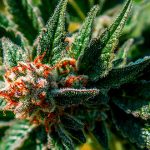Chemicals in cannabis could be effective at treating painful migraines, research has revealed.
And cannabinoids, the compounds in marijuana that make you feel high, may even be better at treating pain than recommended migraine medication.
Researchers found that pills containing the chemicals reduced the pain felt by migraine sufferers by by 43.5 per cent.
And the drug had a number of positive side effects, including stopping stomach aches and pain in the muscles, according to the researchers.
Previous research has found cannabis can reduce migraines by targeting cells in the body that control pain relief and inflammation.
A drug derived from cannabis offers hope for thousands of children living with untreatable epilepsy, a major study has shown. Cannabidiol, a medicine made out of cannabis but with the psycho-active elements removed, halved the seizures suffered by children with a severe form of the condition. Experts at Great Ormond Street children’s hospital in London said the results could make a ‘considerable difference’ to adults and children suffering with epilepsy. The trial, led by Great Ormond Street and New York University, found the syrup, taken once a day, reduced the convulsive seizures by 48 percent in under-18s with Dravet syndrome, a rare and severe form of epilepsy. In five percent of patients the debilitating fits stopped altogether. In the United States, an estimated three million people have epilepsy. More than 600,000 people in the UK suffer with epilepsy and for a third of them – 200,000 – drugs do not work to control their symptoms.
Ian Hamilton, a lecturer in mental health at the University of York, told MailOnline: ‘This research suggests that compounds found in cannabis are as effective as amitriptyline, a traditional prescription medication used to treat acute painful headaches.
‘This provides promise for people who experience adverse effects from prescription medication.
‘The analgesic properties of cannabis have been known for some time so this research adds to existing evidence of the potential that cannabis compounds have in the treatment and management of common health problems.’
For the study, researchers recruited 79 volunteers who suffered from migraines and cluster headaches.
Migraines and cluster headaches have different causes and symptoms.
Cluster headaches come on suddenly and affect one side of the head, while migraines can vary in intensity and can cause symptoms such as nausea and light sensitivity.
The researchers administered an oral dose of a drug containing two compounds from cannabis every day for three months.
The first, tetrahydrocannabinol (THC), is the chemical responsible for most of cannabis’ psychological effects, including hallucination and euphoria.
And the second, cannabidiol (CBD), does not contribute to feelings of euphoria, but is thought to potential therapeutic benefits including acting as an antioxidant.
Patients with cluster headaches were given a daily 200mg dose of the THC-CBD combination drug or a 25mg dose of amitriptyline, an antidepressant commonly used to treat migraines.
And patients with migraines were offered 200mg of the TCH-CBD treatment to take when they felt acute pain.
The researchers found that the TCH-CBD drug was better at reducing the severity and number of cluster headache attacks than common medication.
Cannabinoid treatment reduced cluster headaches by 40.4 per cent, while amitriptyline cut headaches by 40.1 per cent.
And the researchers also found that the drug was effective at treating acute pain caused by migraines, cutting pain severity by 43.5 per cent.
This finding suggests the TCH-CBD drug may be more effective at treating pain than common migraine medication, the researchers found.
The drug was also able to cut pain for cluster headache sufferers, but only if they had previously experienced migraines in childhood.
‘We were able to demonstrate that cannabinoids are an alternative to established treatments in migraine prevention,’ said lead researcher Dr Maria Nicolodi, from the Interuniversity Center in Florence, Italy.
‘That said, they are only suited for use in the acute treatment of cluster headaches in patients with a history of migraine from childhood on.’
Dr Nicolodi added the TCH-CBD treatment had a number of side effects that were both positive and negative.
Positive side effects included fewer stomach aches, reduced pain in the muscles and fewer symptoms of colitis, painful inflammation of the colon.
But negative side effects included drowsiness and difficulty concentrating, the researchers added.
(1169)





Leave A Reply